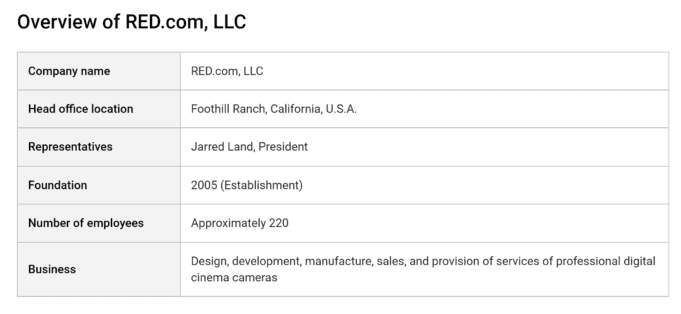I had this crazy dream last night that I just need to share here.
It was a dystopian world, with random lightning strikes all over the place, sort of like Blade Runner (1982) of course. Then over the broadcast system came the announcement:
Nikon has acquired RED!
Even though I was apparently dreaming it turns out I could even hear myself snicker. Don’t be ridiculous. Please wake-up soon.
When I did wake up I realized I had not been dreaming. Somehow I must have been inadvertently doom scrolling in the middle of the night. So I double checked my Twitter X feed and sure enough:
Like many I had to do a double take; surely this was an early April Fool’s prank. Indeed, it isn’t. It wasn’t. All of it is real, backed by a press release — albeit short at only four paragraphs — from Nikon themselves.
Interestingly, note the company mentions in the section below specifically the intent “to expand the fast-growing professional digital cinema camera market…”
“This agreement was reached as a result of the mutual desires of Nikon and RED to meet the customers’ needs and offer exceptional user experiences that exceed expectations, merging the strengths of both companies. Nikon’s expertise in product development, exceptional reliability, and know-how in image processing, as well as optical technology and user interface along with RED’s knowledge in cinema cameras, including unique image compression technology and color science, will enable the development of distinctive products in the professional digital cinema camera market.
Nikon will leverage this acquisition to expand the fast-growing professional digital cinema camera market, building on both companies’ business foundations and networks, promising an exciting future of product development that will continue to push the boundaries of what is possible in film and video production.”
Source: Nikon
Also, it didn’t go unnoticed that the press release included a positive mention of RED’s “proprietary RAW compression technology.”
One final point regarding the announcement itself: there’s no trace of the news on the red.com web site. You’ll only find an official mention of the deal on Nikon’s press room.
RED: End of an Era?
That RED (RED.com, LLC.), maker of high end cinema cameras for Hollywood, indie filmmakers and, increasingly, content creators, would be bought out isn’t much of a surprise. Times are tough for small, startup-like camera companies. Especially against the notable likes of industry behemoths like Arri (Germany) and Sony (Japan). Then there’s the whole AI trend. Couple that with the headwind that is the smartphone (iPhone predominantly) and you can see more than one reason for wanting to exit.
But most of us thought it would be something more… Avant Garde? Like, say, Apple. Or maybe something more in keeping with the industry like a Sony or Panasonic. But Nikon? That old school stills company? (that still makes great cameras nonetheless).
Perhaps that it’s something unexpected like Nikon means that the deal is, in fact, something worth making. That RED provides Nikon something it needs (patents, compressed RAW litigation avoidance) and in return Nikon provides something that RED needs (cash). On that last point, my guess is that for flamboyant RED (and Oakley sunglasses) founder James Jannard and president Jarred Land this a highly prized liquidity event. It’s hard to imagined these two pioneering entrepreneurs and L.A.-centric dudes readily aligning as a “subsidiary” of anything.
Good on them.
RED, as a brand and a product, has been a resounding success. Even if lately it hasn’t been at the pinnacle of major Academy Award work (that would mostly still be Arri and Sony), RED has a firm foothold in Hollywood workflow as a well as that in production hubs across the world. Using RED is a safe choice. People know it. RED RAW and Redcode (.R3D) files are ubiquitous and widely supported and the industry is adept as well at bringing footage to big screens, or televisions.
Now, though, the big questions remain.
The one I’m most curious about: will RED remain as an ongoing brand?
There’s a case to say, yes, of course Nikon management should keep the RED brand a going concern. As mentioned, the industry has familiarity with the name. Why throw away almost two decades of good will?
Others will argue the brand has done more harm than good lately. Plus, reliability has been an issue in the past.
Maybe Nikon will create a new cinema line called “Nikon RED”? It could still leverage its core, iconic brand for high end digital photography, while using a sub-branded version targeted at filmmakers.
Then there’s other odds and ends. Such as what becomes of the Canon RF mount now found on current RED cameras (Komodo, Komodo-X, V-Raptor, V-Raptor XL)? Will it become a Nikon mount at some point? Or does any of that matter despite the new parent company?
Of course, Nikon could always just shut everything down and profit from patents and licenses and maybe RED would simply become an interesting footnote in cinema camera history.
Also, will Jannard and Land remain involved? My guess is no. Why, given the mission is essentially accomplished? That could be a glaring gap going forward should Nikon try to keep inroads alive in the biggest productions which, no doubt, are centered in Los Angeles. There, RED was, in my view, skilled at exposing some of the biggest directors and filmmaking to their products. Michael Bay and David Fincher are just two of many high profile names that come to mind who have an affinity to RED cameras and products thanks largely to face time with Jannard and Land. Without those relationships and, also importantly, a geographical footprint here in California and Nikon could realize the difficulty of winning over production crews at arm’s length.
RED: Love and Hate

Like many I too was smitten by RED back in the day. Or at least the idea of RED. I had shot Canon DSLR for as long as I can remember. I couldn’t afford the legendary Canon EOS 5D Mark II that ushered in the DSLR HD video era. So I worked my way up the entry models from a Rebel to a 60D, then 70D and finally an 80D, before really splurging on a Canon EOS C100 Mk II that we would use here on Stark Insider to cover backstage Broadway, red carpet stuff, and live events up in Napa and Sonoma.
If you’re in video long enough, at some point you get the bug. So when the entry level RED Raven came along I placed an order. Exciting times. Costly times. Soon after I realized the newer Scarlet-W model might be better (only a few dollars more!) as it had a wider FOV, interchangeable lens mount and faster frame rates.
At the time I must’ve had a momentarily lapse of sanity. Checking my past invoices I realized that I had paid the most ever for a memory card for those DSMC2 cameras:
- $1,850 for 480GB
That’s $1,850 USD for a single 480GB RED mini-mag card. One that only works in RED cameras. By comparison, you can get 512GB CFexpress Type B cards (many newer camera models including RED’s own Komodo-X thankfully use them) for $199. Just crazy the difference how a closed system (mini-mags) can create a fountain of profit at the cost of its users. Fortunately, those days are over.
So that was one of the things I didn’t appreciate so much as a RED user.

Then there was the whole bro culture marketing thing. Kind of annoying. All that in the woods, driving motor bikes and drinking whiskey while shooting slow motion music videos stuff at night with the boys. All really grating. Pair that with the skull and crossbones style branding and overall aesthetic to RED’s early marketing and it was off-putting to say the least. Yes, we get it. You’re (we’re) rebels! Fighting against the staid overlords of Arri and Sony to release are inner bros. To me this is a creative tool — a paint brush! — not some sort of battle scythe middle aged men need to use for therapy. And on this point I will say it would be quite something to sit in on some of the upcoming meetings between the Nikon (Japan) team and the RED (USA) teams.
Sony:
The Cinema Juggernaut
As an aside it’s worth pointing out how complete Sony has mapped out its cinema camera line-up in recent years. In my estimation, at least, it’s the most well-rounded with cinema-specific models ranging from $1,798 USD for the APS-C compact FX-30 body, all the way up to $60,000+ for the flagship Sony Venice 2 used on many of today’s Hollywood features.
Also, Sony has the Burano now shipping this month, a $25,000 8K mid-range camera that should appeal to potential RED buyers — it’s right in that sweet spot for many productions. It’s hard to deny how well Sony has executed in the marketplace.
Below is my unofficial take at Sony’s current cinema camera line-up, not including broadcast and specialty models.
Sony Cinema & CineAlta Line-Up 2024
Sony FX30 // 4K APS-C, $1,798
Sony FX3 // 4K Full-Frame, $3,898
Sony FX6 // 4K Full-Frame, $5,998
Sony FX9 // 6K Full-Frame, $9,998
Sony Burano // 8K Full-Frame, $25,000
Sony Venice 2 // 8K Full-Frame, $60,000+ (?)
Despite the bumps here and there, I could never envision selling my RED Dragon. The image it to die for. Many modern users will prefer noise reduction and sharpening. Today’s iPhone is masterful at image manipulation and producing a social-ready result. That Dragon sensor, though, is something special. To my eyes it’s a phenomenal approximation of digital film. It just looks glorious, grain and all. I’ve never had a better image come out of any camera I’ve ever owned in the past. I never tire of reviewing footage out of that Scarlet-W.
If the sensor is the chocolate then the Redcode is the peanut butter. Just divine. RED files play natively in Premiere Pro (and I suspect other NLEs as well such as Final Cut and DaVinci Resolve) without any transcoding. Playback is butter smooth. And, as widely known, you can use source settings to tweak the image pretty much at will. White balance. Exposure. Contrast. Color wheels. Highlight roll off, etc. All of it means you can focus on the project at hand, and not worry about all the other, often necessary, steps required to work with the files produced by other cameras. When they talk about “digital negatives” I get what they mean, and I’ve fully bought into the idea (cult and all). It’s creative utopia.
Other Potential Acquisition Targets
More Consolidation to Come?
During difficult times such as the dedicated camera marketplace is facing thanks in large part to the smartphone and massive players such as Canon and Sony and Arri, consolidation can become a key, long-term survival play.
Here’s some other names that come to mind as potential acquisition targets (pure speculation):
- Atomos (Australia) — camera monitor/recorders
- Blackmagic Design (Australia) — cameras, broadcast and audio-visual gear
- Smallrig (China) — camera accessories, stabilizers
- Kinefinity (China) — cameras
- DJI (China) — drones, stabilizers
- GoPro (USA) — drones
- Sigma (Japan) — lenses, cameras
- Z CAM (China) — cameras
Yes, Nikon Was Cool
I don’t know much about Nikon. I shoot Canon and RED, and own almost all EF/EF-S glass including a vintage lot handed down by the Stark men. I have one special lens in the form of a crank-able Angenieux zoom (C mount) that I adore and might be the sole reason why Blackmagic cameras with their Super 16 options sometimes find there way into our experimental video projects. When I travel I bring along a compact Sony Alpha a6000 that is just magic to use, even after all these years (Fujifilm X100VI be damned!).
But I do know this about Nikon.
Dennis Hopper was the coolest Nikon user ever. Who can forget him, as “photojournalist,” loafing around the jungles of Vietnam in Apocalypse Now (1979) with a bunch of Nikon cameras dangling from his neck? A hipster influencer before his time. A brand ambassador perhaps ready for reincarnation if ever there was a perfect place and time.
Yes, Nikon was cool. Can they be again? My guess is RED may know the way.
In other industry-related consolidation news: Lensrentals Acquires BorrowLenses



